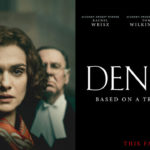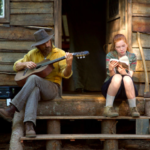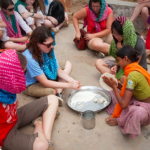
A few weeks ago, I had an extraordinary experience that I feel I have neglected to tell. I have been hesitant to tell this story for a few reasons. For one thing, I haven’t been sure of the outlet in which to feature it. I have wondered if the Culture Mom is the right venue for a story of such an important, historical nature. I often write about plays I see, trips I see, my children. Is this the right forum for such a story? Well, to answer that question, this blog is anything that I want it to be, so I have to say it is.
For another thing, I didn’t take the best notes during the meeting I am about to tell you about. I reunited two fascinating women from an important time in our history and I didn’t take notes. For that reason alone, I feel like I missed an opportunity to share their exact words and I did take my phone to record their voices and a notebook to record my thoughts. But you have to understand that the hour spent with them was just that powerful, and the experience meant just too much to me. I wanted them to feel that I had brought them together for nothing else but for them to get pleasure out of meeting together. I didn’t want to them to think I was just there for “the story”.
Bringing Holocaust Survivors Together
And what a story it is. I was able to bring two Holocaust survivors together from the Lodz Ghetto in Poland. It’s a long story of how I met each one, but I can summarize and try not to lose you in the process. I am on the Holocaust Committee at my synagogue and have been interviewing survivors over the last year.

One of those survivors was Esther Geizhals, age 84. I wrote about her life over at The Broad Side almost exactly a year ago. She was born in Lodz in 1929. At the age of 10, she and her family were moved to the Lodz ghetto where they lived under terrible conditions until 1944. At that time she was transported to Auschwitz extermination camp. Six weeks later she was moved again to Bergen Belsen and on to Rochlitze concentration camp in Czechoslovakia. In 1945, as the allies were advancing, the whole camp was made to walk for days without food or drink and just a few hours of sleep on fields. Many died and later this was known as the death march. Mrs. Geizhals and four other people escaped during the death march and worked their way to the next village where they were liberated by the Russian army. Eventually she managed to get back to her hometown of Lodz in the hope of finding any survivors of her family. She was very fortunate to find her father who was the only survivor of her family and relatives. Mrs. Geizhals smuggled her way from Poland to the American zone in Germany, where she lived in a displaced persons camp until 1947 at which time she came to the United States with a youth group. Esther married and has lived in New York since the age of 22. After her first husband died, she took over his effort of educating the general public about what happened to them during the Holocaust so everyone would know what happened to them. She speaks at a lot of high schools and synagogues and is very vocal about what happened to her.
After I interviewed Esther, some time passed before I was in touch with her. I actually may have offended with her with my silence but when I met Salomea Kape-May by accident in a cafe’ in the town where I live, I felt obliged to get back in touch. Salomea was sitting in my local Starbucks when I was there doing research for a paper for a Graduate School class I’m taking. I was there to observe a particular population, in this case the elderly. When I realized how difficult my research would be without actually talking to my subjects, I introduced myself to Salomea. We then ventured into the most amazing conversation and a quick friendship was formed. It wasn’t long before I learned she was from Lodz, and when I told her about Esther, she eagerly asked for a meeting. She couldn’t believe that there was another woman from Lodz in the same town. The funnier thing is that their two apartment buildings touch, they are so close.

Dr. Salomea Kape was born in May 1926. In 1940 her family was imprisoned inside the Lodz ghetto along with other Jews. She attended the ghetto high school. Her mother worked as a midwife in the ghetto hospital. The family stayed there during the liquidation of the ghetto and lived as normal a life as they could, though the conditions were horrible. They survived there until liberation by Soviet forces in January 1945. After liberation, Salomea was able to complete her education. She graduated from medical school in 1952. In 1957, Dr. Kape and her husband Mendel left Poland. Their son John was born in 1963 in Israel. The Kape family moved to New York in 1966 where she has lived ever since. She retired just about eight years ago from the medical field. She is extremely prolific and is writing a book about her experiences that is being published in Poland this summer. She also translates work for the Museum of Jewish Heritage in NYC and has recorded testimony at the United States Holocaust Museum, which you can listen to here.
When the two women met for the first time in Esther’s apartment, it was calm and collected, not as emotional as I had expected. Here we had two women with similar yet very different pasts. They remembered streets, synagogues, shops, what is was like before things turned. They talked about better days before Hitler came into power, which brought smiles to their faces, as well as the lives they came into after the war. But they both knew that Esther had a far more difficult time in the death camps. She kept shaking her head and saying, “What I went through, you can not imagine.” Salomea could not disagree.
There was much sadness that passed between Esther and Salomea, but also joy. The joy of lives led despite the fact that they were both nearly killed all those years ago. There is no denying the connection made between two Holocaust survivors. It is a bond like no other.
Do I wish I had more to tell you about the hour I spent with these two women? I do. But I am also grateful for the experience – it is mine. I will never forget what it was like being in the room with them nor will I ever stop telling these important stories.







 Follow
Follow





Speak Your Mind